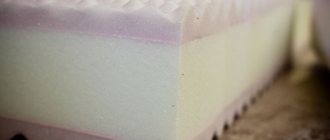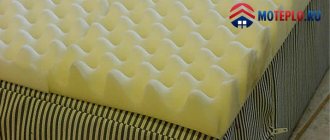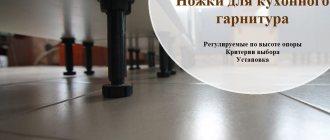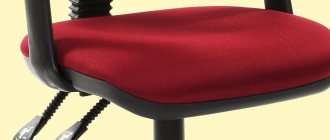What is PPU filler in a sofa?
The PU foam filler for sofas is polyurethane foam or furniture foam rubber. It has a porous structure and consists of 90% air. It has highly elastic properties, giving softness and elasticity to the product. Thanks to these characteristics, it is actively used as padding for furniture, car seats, orthopedic mattresses, toys, dish sponges, etc.
The sofa can consist entirely of polyurethane foam and be springless, or it can be a combination one, in which several fillers are combined at once (example in the photo below).
There are two main types of polyurethane foam:
- Block - consists of large sheets of polyurethane foam, from which the manufacturer cuts out the necessary parts. The product is made from blocks of different widths and densities. Such production is less expensive in price, but after it a large amount of trimmings remains.
- Cast - this type is poured in the form of a thick foamed liquid directly into a mold of the required size. The result is a finished part and no waste. But there is also a minus: with such production, a crust appears on top of the polyurethane foam, which does not allow air to penetrate inside.
Photo: Sofas with polyurethane foam filling
Filler: types
Let's look at what types of polyurethane foam there are. There are two of them:
- Block is a large block. This material is purchased by the manufacturer from suppliers and cut into layers of the required shape and thickness. The result is a part of the sofa, glued together from sheets of different densities.
- Molded polyurethane foam. It is produced in a factory: a prepared mold is filled with hot liquid. Next, a chemical reaction occurs and the filler takes the desired shape under pressure. The result is a block that corresponds to the given dimensions. The advantage of this method is that there is no waste left. However, there is also a minus: a characteristic “crust” is formed on top of the polyurethane foam, which does not allow air to pass through well. But there is no other way to make sofas of various non-standard shapes, so you can put up with this little detail.
It is worth noting! The cast type is more expensive than the block type due to the creation process.
Both options are good, so the choice is up to the buyer.
Polyurethane foam filler for sofas: pros and cons
Advantages of PPU
- safe for people with allergies;
- easy to maintain - does not accumulate dust inside itself and has good air permeability;
- has a long service life and high wear resistance;
- thanks to its elasticity, it easily takes the curves of the body and quickly restores its original shape;
- a large selection of hardness levels, so that everyone can choose comfortable furniture just for themselves;
- it is possible to produce products of any shape, even the most complex configuration;
- one of the most economical materials.
Flaws
- unscrupulous manufacturers often use furniture foam rubber of poor quality, which reduces its service life and increases the likelihood that the furniture will quickly sit out and change its original shape;
- does not tolerate direct sunlight and may begin to deform. During production, it is desirable to use light-protective materials as upholstery;
- polyurethane foam is a flammable material.
Characteristics of polyurethane foam
Sofas with this “filling” are distinguished by the absence of wire blocks. The internal space is occupied by polyurethane foam. The material is a type of foam rubber. In addition, in the production of some types of filler, special equipment is used, thanks to which contour cutting occurs. This fact ensures the aesthetic appeal of the sofa.
Convenience
A comfortable sofa is a priority for most people. For a comfortable rest, it is necessary that a dent does not form under the person, otherwise the time of relaxation will turn into a search for a comfortable position. The body load should be distributed evenly across the mattress.
Worth knowing! Inexpensive models use Chinese filler, the service life of which is much shorter than its European counterparts.
In mid- and high-class sofas, manufacturers use polyurethane foam produced using special technology. Therefore, it has a number of advantages, for example, elasticity, long service life, the ability to restore its original shape, etc.
Quality
Sofas with PU foam filling are not inferior to, and often superior to, models with spring blocks. This is felt in quality, convenience and performance. The furniture set with polyurethane foam is suitable for use in any room.
Durability
Sofas with such filling are practical, comfortable and have a long service life. In addition, dust and other small debris do not accumulate in the material, it allows air to pass freely and is completely safe for health.
A sofa with polyurethane foam is inexpensive due to its fairly simple production technology. The price of such furniture is much less than a furniture set with spring filling. The cost starts from 10,000 rubles.
Which filling is better for a sofa: PPU or spring block
A spring block is considered a softer padding, and for those who like hard sofas, it is better to choose polyurethane foam. Both fillers have advantages and disadvantages, and you need to focus on your feelings. Before buying, you should definitely test the furniture for convenience and comfort: sit and lie on it.
If the choice fell on a spring block, then it is better to choose a block with springs independent from each other; it is more comfortable, elastic and wear-resistant. If you choose polyurethane foam, you should pay attention to the thickness of the material and its density; the thickness should be at least 4 cm, and the density should be from 30 kg/m3. There are also products where polyurethane foam and a spring block are adjacent to each other.
PPU is a modern filler, in no way inferior to spring filler. It is advisable to choose a sofa that is not in the budget category. It should be noted that when using any packing, manufacturers may use low-quality raw materials and outdated technologies. The cheaper the furniture, the worse the quality of the materials used. Sometimes such savings can quickly affect the loss of the original appearance of upholstered furniture, as well as your health.
Source: poztelio.com
Which sofa filling should you choose: spring block or polyurethane foam?
When choosing a sofa, many of us focus on its appearance (type and color of upholstery, shape of armrests and back, various decor, etc.), some look at the transformation mechanism, but few people think about what is hidden under the fabric. But the orthopedic qualities of the sofa and your comfortable sleep directly depend on this.
Let's take a closer look at the options for internal filling of upholstered furniture and figure out what is preferable to choose. I want to tell you about various nuances that sellers in furniture stores do not know (or do not want to talk about).
Let's start with the fact that there are two main types of filling:
- spring block.
- furniture polyurethane foam.
I’ll say right away that there is no ideal option, and each type of filling has both its strengths and weaknesses.
Which filling to choose for a sofa?
How often do you choose upholstered furniture based on its appearance, without thinking about what’s inside? But the internal content is no less important. The reliability and durability of the seat, back and armrests, as well as the comfort and ease of seating directly depend on the filling for the sofas. Therefore, you need to approach its choice no less carefully than choosing the color of the upholstery or the shape of the sofa.
What is better - springs or highly elastic polyurethane foam (PPU)? We talk about the most popular materials and help you decide which filling is best for your sofa in order to get a comfortable and durable place to relax for many years.
The best springless synthetic fillers
- Many furniture manufacturers prefer to use polyurethane foam because it is an affordable material and easy to work with. There are two types - cast and block. In the first case, special forms are filled with the necessary composition, similar in thickness to sour cream. After it hardens, you get the desired shape. In the second case, the sheets are cut into layers of the required thickness and size and glued together.
Furniture polyurethane foam - an affordable and convenient material for frameless furniture
- Synthetic down. The spiral-shaped fiber, made of silicone, restores its previous shape after compression in a matter of minutes. It has such properties as good quality and reliability. It is mainly used for stuffing furniture pillows, as a filler for backrests and armrests.
Synthetic down - the artificial material of the future
- Sintepon. Non-woven, very lightweight material made from polyester fibers. The substance is hypoallergenic, so furniture with synthetic padding as a filler is used in children's rooms and is suitable for people prone to allergies. They also stuff pillows and use them in making clothes. Eco-friendly material, does not wear out for a long time, is resistant to various fungi, has a water-repellent property, and is safe.
Synthetic winterizer is a material suitable for people suffering from allergies.
- Periotec. Looks like weightless, plump felt, is safe for allergy sufferers, and may contain wool or cotton fibers. The density of such furniture can be normal or high.
PerioTek filler is an elastic, voluminous and durable material
- Quilted jacket. This is, in fact, a layer of cotton wool 5-10 cm thick, located between layers consisting of dense fabric. Furniture with such filling is soft, but there is no elasticity.
Padded padding for the manufacture of upholstered furniture
What is it: classification of fillers
There are two large groups of upholstered furniture fillers: with springs and without springs.
In the first case, several layers of natural or artificial covering material - coconut coir, latex, foam rubber, felt, etc. - are laid on cylindrical springs or a base made of a spring “snake”. The different densities of a particular coating and many spring options make it possible to create fillings of different degrees of rigidity.
Springless fillers are based on highly elastic polyurethane foam (PPU, furniture foam rubber) - an inexpensive, but durable and elastic artificial material.
Reviews
Anastasia, 37 years old
“We purchased a sofa from Avangard with polyurethane foam filling 4 years ago. Until now, all mechanisms are working properly, there are no dents. I recommend purchasing."
Alexander, 42 years old
“When buying a sofa in a store, they advised me to purchase furniture with PU foam filling. At first I wanted to refuse, but then I tried the sofa on myself and liked it. It's been in the living room for 2 years now. There are no problems, the only thing is that it’s a bit harsh. I recommend it. Matching filling and sofa.”
Springs
The spring block comes in two types: with dependent (Bonnell type) and independent springs. Both options are very durable, provided that there is a sufficient number of intermediate layers between the block itself and the outer upholstery.
Dependent spring block
A classic, time-tested option. Here all the springs are connected to each other by a continuous spiral steel wire. If you press one spring, the others will immediately connect to it, thereby distributing the load across the entire base. The structure is attached around the perimeter to the edging frame and covered with an intermediate layer of non-woven material.
Independent spring block
In a block of this type, each spring lives its own life” and does not depend on its neighbors, which gives the surface high point elasticity and allows it to better adapt to the contours of the body.
Spring snake
Attached to a wooden or metal base using a hinged bar or steel brackets, the “snake” is a simple and inexpensive spring base. And although it is not a full-fledged filler - a layer of polyurethane foam is always laid on top - it can withstand heavy loads, does not deform and is very durable.
Polyurethane foam (PPU or furniture foam rubber) is an inexpensive and highly elastic furniture filler. Provides a comfortable fit, has good elasticity and is environmentally friendly.
For the base of a sofa with such filling, as a rule, block furniture foam rubber is used, cut and twisted in a certain way. Some models require special molded polyurethane foam blanks, which are also used as a filler for pillows - the material allows you to hold any shape given to it.
The PU foam filling in the sofa comes in different brands - standard, luxury PU foam, memory foam foam, etc. The higher the properties of the material, the more expensive the sofa will cost to manufacture.
Other materials
Furniture fillings are not limited only to foam rubber and springs - other materials are also used as additional layers for filling.
Natural latex
A base made of natural latex is often used in expensive upholstered furniture - the material is highly elastic, instantly restores its original shape, is non-toxic, hypoallergenic and has a long service life.
Sintepon
The most inexpensive, but very durable artificial filler. It creates additional softness and elasticity. Also, the material is not susceptible to fungus formation. The main disadvantage is that with regular use it does not hold its shape; characteristic dents and irregularities appear on the surface. In case of constant use, this material should be considered in combination with polyurethane foam as a covering layer - its share in the filling is small, but one way or another it can improve the shock-absorbing properties of the seat.
Holcon (struplast)
A modern non-woven material consisting of an intermediate layer of vertically laid synthetic polyester fiber and two covering layers of dense reinforcing ribbed surfaces. This method of laying allows the mattress or pillow to sag only in places of pressure and quickly restore its shape.
Holcon is easy to care for, retains heat well, has increased elasticity, is environmentally friendly and does not absorb moisture and odors.
There is no definite answer to the question of what is the best filling for a sofa, but you can protect yourself from inconvenience and disappointment by choosing the “filling” according to the purpose of the future sofa. So, for a sleeping place it is better to consider a filler with a more rigid and flexible base (highly elastic polyurethane foam, independent spring block, natural latex), because Regular rest on an overly soft or creased bed can have a bad effect on the spine. But the guest option provides for any content.
Source: m.divan.ru
PPU 22 density for sofa reviews
You should choose the filler for upholstered furniture based on your intentions for using the sofa. If the future purchase is assigned the role of a permanent sleeping place, then the filling should be harder: doctors do not recommend sleeping on a very soft bed. If the sofa is intended mainly for sitting, and performs the sleeping function for a short time (when staying overnight for late guests, for example), then the hardness of the filler does not matter much.
Comfortable furniture should be soft and resilient. Only in this case we have the opportunity to completely relax, removing the load from the spine. A special seat design – “layer cake” – will help achieve this effect. There should be a thin layer of foam rubber of lower density and rigidity on top, and a more elastic layer on the bottom. Such a sofa gives the feeling of a moderately inflated tire - not flaccidity, but elastic firmness that does not turn into rigidity.
Furniture filling is not limited to foam rubber and spring blocks. Various synthetic fibers are used, the most common of which is padding polyester. Typically, polyurethane foam is covered with a layer of synthetic padding on top to give additional softness and texture and at the same time insulate the foam rubber. For the “filling” of expensive furniture, highly elastic polyurethane foam and natural latex are used.
Many people believe that a good sofa must have springs. This is the only way, they say, to ensure an orthopedic effect. But often the quality of these same springs does not stand up to criticism. They quickly wrinkle or break due to improper hardening. Spring blocks must be covered with a multi-layer “blanket” made of felt, felt, foam rubber, batting, copra and many other components of a good spring mattress. Not everyone can afford it. Therefore, many manufacturers reasonably believe that high-quality foam rubber is better than cheap springs.
Foam rubber (also called soft polyurethane foam - PPU) can be standard, hard, soft, highly elastic (latex), etc. Each PPU has its own purpose. In the most loaded areas of the sofa, the foam rubber should be denser (for the seat, the density of the foam should not be lower than 28-30 kg/cube, m, for the back - at least 23-25 kg/cube, m, for the armrests - 20-22 kg/ cube, m). Today, this rule is rarely observed by domestic furniture manufacturers. It is not profitable. After all, the price of polyurethane foam is proportional to its density.
The internal structure of modern upholstered furniture is a complex system of soft materials and a springy base. To give furniture comfortable rigidity, rubber belts, wooden strips - flexes (springs) and spring blocks are most often used. And if the second part of the term “sofa bed” is extremely important for you, then you should choose a sofa with flexes or springs.
As for softeners, they most often are polyurethane foam, furniture foam rubber, latex and holofiber. When choosing between foam rubber and polyurethane foam, it is better to give preference to the latter - it is harder and does not lose its qualities longer. But the new generation material - holofiber (specially processed silicone) will appeal to those who like to pamper their sides on soft stuff - it is also called “artificial down.” Holofiber is not a cheap material, and it is usually used to fill furniture in the “above average” price category.
Your sofa can be soft due to foam rubber, a spring block, or polyurethane foam. It’s difficult to say unequivocally which is better. It depends on your feelings, how pleasant this or that padding is to your body and on the quality of the foam rubber or springs. But there are several patterns. The softer the foam, the easier it crumbles. Sofa cushions stuffed with synthetic padding or foam rubber crumbs will very quickly lose their shape. A sign of good form is the use of a solid piece of foam rubber. Companies that care about their prestige provide all sofa covers with a zipper so that the buyer can, firstly, find out what he will be sitting on, and secondly, change the stuffing over time. In properly designed models, sofa cushions are placed at a slight angle, slightly supporting the person sitting under the knees, preventing him from moving out. If it is a solid block of polyurethane foam, it will have a slight edge.
Which foam rubber to buy for a sofa: what to look for
Hi all! Some create furniture from scratch, while others simply need to replace elements of old furniture that are worn out and no longer suitable for further use.
A striking example here is foam rubber for a sofa. Even in high-quality furniture, it can wear out and sag over time. This violates the desired level of comfort, and therefore the foam needs to be replaced.
Self-assembly is even easier. To reupholster, you first need to lay something soft under the sheathing material. And here the best solution would be foam rubber.
And so that it does not get pressed, the pillows can serve for a long time and create a high level of comfort, you need to approach the issue of choice wisely. Therefore, today I suggest you find out how to choose a suitable product, how important parameters such as density, thickness and hardness play, and what are the key nuances of purchasing this product.
What it is
If you are thinking about how to replace worn-out foam rubber in furniture, then the best option is definitely to purchase the same foam rubber, or even higher quality. Before studying the types and trying to find out which is better, let’s understand the very essence of the material.
Foam rubber is a type of polyurethane foam, therefore the material can also legally and reasonably be called polyurethane foam. The strong opinion about foam rubber as a low-quality material is no longer relevant.
Currently it is used as:
- furniture upholstery element;
- popular packaging material;
- isolation;
- material to ensure heat conservation of various pipes;
- construction material;
- component for sports mats;
- filler for children's playrooms, rooms, etc.
Buying polyurethane foam of various types for appropriate purposes is not a problem at all today. And it doesn’t matter whether you live in Tyumen, cities like Chelyabinsk, Volgograd, Perm, Krasnoyarsk, Moscow or in some suburb. There are hardware stores everywhere. Plus, he does not forget about the possibility of purchasing inexpensively at retail in Leroy Merlin and through online stores.
Varieties
If we talk specifically about furniture foam rubber, then replacing it with material used in construction is not the best idea. Furniture production is constantly being improved, which allows us to improve technology and improve quality.
Several types of polyurethane foam are used simultaneously in sofas, since each section requires appropriate characteristics.
Foam rubber is divided into the following types:
- Standard. Marked with ST symbols. It is produced with different densities and can be used in various fields;
- Hard. You will recognize it by the HL marking. The best in terms of strength, but the scope of application is much narrower;
- Increased rigidity. Marked with EL. The structure is solid and can withstand heavy loads;
- Soft. It is labeled as HS. Creates comfortable landing surfaces, but easily bends under the influence of weight;
- Highly elastic. Its marking is HR. With relatively low rigidity it can withstand heavy loads. Easily and quickly restores shape;
- Viscoelastic. It can adapt to various forms of loads and weights, while distributing it over the entire available surface.
It’s difficult to say clearly which one is better. The price of products varies, which largely depends on parameters such as density, hardness and manufacturer’s brand. If we talk about how much a product costs, then prices can vary from several hundred to several thousand rubles, and sometimes more.
This is not really a complete classification. But in terms of filling the sofa, we are of little interest in non-flammable, secondary foam, reticulated and other subcategories of polyurethane foam.
Functions and Features
Various types of furniture foam are designed to perform specific functions and fill different compartments of the sofa. After all, when one sofa is made, it simultaneously includes several types of foam rubber with different characteristics.
- Standard. The most popular and widespread. It is used in furniture production and for self-assembly or restoration. It is actively used in the design of corner sofas and children's sleeping places. But the downside is that it can’t handle heavy loads. The densest option cannot withstand more than 90 kg of weight;
- Hard and polyurethane foam with increased rigidity. Well suited for sofas where people often sleep. These foams are used to fill mattresses. High density and no weight restrictions make this foam an excellent choice. But to increase comfort, it is recommended to lay another layer of polyurethane foam on top, but softer;
- Soft. Rarely used as the main filler in sofas. Designed for a softening function, therefore it acts as a layer after hard polyurethane foam. They are mainly used in the backs and cushions of sofas. It wears out quickly and does not last more than 5-6 years;
- Viscoelastic and highly elastic are quite exclusive, rarely found on sale and are expensive. They are used in the production of the most expensive and luxury furniture. The best types of foam rubber among all existing ones.
Recommendations for selection
If you are faced with the task of choosing the optimal foam rubber for all characteristics that will be used in the sofa, listen to a few practical tips.
- Look at the density parameters. This is the first thing people pay attention to. In fact, a density of 30 to 40 units is ideal for organizing the sleeping area of a sofa. It will be comfortable, soft enough, but will not wear out quickly. For seats and sleeping areas, choosing a density less than 30 is not recommended. And for armrests and backrests, 20-30 units are enough. The density indicator appears in the marking immediately after the letters. That is, something like ST 3542. Here the density is 35;
- Rigidity. Having decided on the density, immediately look at the hardness. It follows the first parameter in the standardized labeling. If you look at the sample above, the hardness there is 42 units. In general, foam rubber can have a hardness in the range of 15-45 units. The higher the value, the harder the product will be;
- Strength. Displays the force required to cause the foam to tear or stretch. The higher the strength, the longer the polyurethane foam and the entire sofa will last;
- Parameters of residual deformation. This characteristic indicates the ability of foam rubber to return to its original shape and the time spent on recovery. If the coefficient is high, this is bad, since such characteristics indicate low quality of the product.
In fact, you need to be extremely careful when choosing the foam rubber with which you are going to fill the sofa.
The thickness of the product actually doesn’t say anything. Even thick sheets of foam rubber can wear out quickly, sag under a fairly small weight and not restore their shape after the influence of body weight stops. As a result, your sofa will not live up to your expectations at all. And the fault will simply be an incorrectly selected filler or softener. Now call it what you want.
I would like to note that it is not necessary to chase very thick polyurethane foam to lay it in one layer under the upholstery of the sofa. You can take a thinner product, but with good characteristics. The material is used in one layer for backrests and armrests, but when folded in several layers, the result is an excellent soft, quite elastic and deformation-resistant sleeping place. After all, thicker sheets are noticeably more expensive. This is already a small trick to save money without sacrificing quality.
You can clearly see that the choice of furniture foam rubber is associated with certain nuances, requires a competent approach and must take into account several basic characteristics.
But I am sure that you will be able to cope and make the right choice. Therefore, I can only wish you good luck with your purchase.
Thanks to everyone who reads us! Subscribe, leave comments, ask questions and don’t forget to tell your friends about us!
Source: vmk-mebel.ru
Spring block
The spring block is not modern, but is still popular
They are distinguished depending on several factors:
- thickness of the metal rod that is used for the spring
- number of springs per 1 sq. m
- spring diameter
- spring height
These data together determine the anatomy of the sofa, i.e. its ability to adapt to the position and structure of the body. Springs made of thinner rods and small diameters better support the body and follow its contours. The total number of such springs per 1 sq. m. affects the ability of the product to withstand heavy weight and the period of operation.
- long period of operation
- ability to withstand heavy body weight
- reliability
- orthopedic properties beneficial for the spine
- smooth surface, with sufficient elasticity and rigidity
- good air and moisture exchange
- Over time a squeak appears
- expensive repairs
There are 2 types of spring blocks
The rigid connection between the springs affects comfort
Springs are made from high quality steel. To connect them, high-carbon steel wire with knots is used. Everything is secured with lower and upper metal frames. The total number of springs depends on the manufacturer. In this design it is 100-150 pcs/sq. m.
The bonnel block is very reliable and resilient. It is capable of holding heavy loads. People weighing more than 100 kg can safely use such a unit. Metal frames make the structure even more stable, because eliminate swaying and sideways movement of elements. This increases the service life of the unit.
The top of the springs is covered with additional filler, such as felt, padding polyester, or other materials. This softens the feel of the springs, making the product more comfortable.
A good option for a sofa in the living room.
Each of the springs is an independent element
Non-woven fabrics have the maximum level of strength and are environmentally friendly. The material is not subject to rotting, which prevents the development of bacteria and fungi. Has good resistance to all types of friction.
The covers are attached to each other using flexible connections, which enable each spring individually to demonstrate its elastic qualities. The structure itself is additionally glued with non-woven fabric on both sides. Due to this, its shape is strengthened. Block deformation is eliminated. It is protected from mechanical impact. Springs are used from thin wire and small diameter, and their number in this design reaches 350 pcs/sq. m and above. These characteristics indicate a high level of comfort of the filler. It is not subject to sagging or vibration when changing body position, and is silent in use.
This design distributes the load pointwise and follows the contours of the body, ensuring the correct position of the spine regardless of how the person is positioned.
The price of such a block, compared to a Bonnell block, is significantly higher. This is explained by the fact that manufacturing the structure requires more time, labor, and costs.
A good sofa option for good sleep and relaxation. Such a filler will not solve back problems, but will help cope with fatigue and tension in the muscles, and relieve the load on the spine.
Which sofa is better - spring or polyurethane foam?
Previously, only springs were used, but over time they were replaced by other types of materials. You can only understand which type is better by comparison: seek advice from the manufacturer, read the information on the website.
Buyers are sometimes confused as to which is better, a spring or polyurethane foam, and cannot make a choice.
Different models can be attractive in their own way. Let’s figure out which filling for a sofa is better and more reliable than polyurethane foam or a high-quality spring block.
PPU is the same foam rubber, used almost everywhere, in particular, as a filler for furniture.
Characteristics
Each of the two materials has its own characteristics:
| Name | Characteristics |
| PPU |
During the manufacturing process the following is processed:
|
| Spring block |
|
It is widely used as a filler due to its compactness; this property gives softness and elasticity to the product.
You can purchase a design with any type of spring: snake, bonell or independent spring system.
Advantages and disadvantages
Let's look at the strengths and weaknesses of each packing option:
| Material | Advantages | Flaws |
| PPU |
|
|
| Spring block |
|
|
The main quality is that dust does not accumulate in it, it is completely hypoallergenic. This ability is important for those who are prone to allergies.
For a person with back problems, polyurethane foam may be too hard and uncomfortable.
Spring snake
Simple and inexpensive spring base
The snake spring block is also a type of filler. Very often used in the furniture industry, including sofas. Used in soft elements, mainly in the seat and backrest.
The springs are made of galvanized metal and are attached transversely to the wooden base of the sofa with hinged strips or clips. Their number depends on the size and purpose of the product. The base of the structure is made up of these springs. The top is then covered with a layer of felt, batting or foam rubber.
The spring snake allows air to pass through well, so any moisture will evaporate and the product will dry quickly.
The seat has a springy effect and is quite soft. Not resistant to heavy loads. After a short time it begins to sag. This is a big disadvantage for sofas with such filling, which are not recommended for frequent use and are not suitable for sleeping.
Polyurethane foam
For those who love comfort no less than savings
Polyurethane foam sofa filler (PPU) is a synthetic porous substance or furniture foam rubber. Consists of cells that are filled with air. The volume of the material is 90% air. It is used in furniture production as a flooring material or, due to its compactness, as the main filler for sofas.
PPU is produced in 2 types:
The molded type is denser and costs more.
The material also differs in density. The required density indicators for furniture are 30-40 kg/sq.m.
- high-quality material can last a very long time
- environmental Safety
- recovers in shape after exposure to stress
- It allows air to pass through well, which prevents possible moisture from accumulating in it.
- has thermal insulation, antibacterial, antifungal, antiallergenic properties
- cheap types become unusable over time and begin to crumble, and heavy loads can leave dents in them
- deforms in direct sunlight. To avoid this, the filler is covered with a special upholstery that protects it from the sun.
- Many consumers do not like the higher density of polyurethane foam, because products with such a surface are very hard
This sofa will be a wonderful sleeping place. The polyurethane foam filler is not inferior in properties and comfort to an independent spring block, but it is more affordable in price.
The best springless natural fillers
Any filler that is used in the production of upholstered furniture or mattresses has its own properties.
- Natural latex. It is made from the sap of the rubber tree using individual technology. It is foamed, resulting in the formation of cells, so it “breathes”. Excellent heat and moisture conductivity, solid material, very high quality. Shelf life is approximately 10 years. Instantly returns to its original shape after heavy loads. There is only one drawback - the very high price.
Latex mattress - high quality, comfortable and safe
- Horsehair. Excellent filler. The horse's mane is treated with latex. This is done to ensure that the material is elastic and long-lasting, moisture-resistant, and breathable. High quality filler, but expensive. Not suitable for people prone to allergies.
Horsehair for the production of upholstered furniture and mattresses
- Coconut coir. Fibers are produced from the coconut intercarp; just like horsehair, they are treated with latex to make them elastic and strong. In addition, they also have antibacterial properties, are hypoallergenic, environmentally friendly, do not rot, and are breathable. Furniture with such filling is perfect even for small children.
Coconut filling for children's mattress
- Sea grass. The most environmentally friendly filler. During manufacturing, the raw material is combined with jute. The furniture has sufficient rigidity, which is beneficial for the back and maintaining the health of the spine. In addition, this filler strengthens the immune system and normalizes sleep, as it contains iodine and various minerals.
Useful and healing filler for upholstered furniture - sea grass
- Bamboo fiber. Produced from young bamboo shoots. The material is able to absorb water vapor, allow air to pass through, and has anti-allergic and antibacterial properties. It is not subject to rotting and does not deform for a long time.
Bamboo fiber is ideal for mattress covers, blankets and pillows
- Camel's wool. Excellent breathable material, can absorb static electricity. Not suitable for people prone to allergies.
Camel wool is an excellent warm filling material for blankets, pillows, blankets, mattress covers and winter mattress options.
- Felt. Made from sheep's wool. Has good thermal conductivity. One of the disadvantages is that it can accumulate moisture, which can cause mold to appear.
Natural felt for furniture and other industries
Natural latex
Ideal for all sleep products
Natural latex is made from rubber of natural origin. Rubber in its pure form is very capricious, so it is supplemented with an inhibitor.
The material is widely used in filling furniture. The proportion of rubber in such a filler should be in the range of 45-65% in order for it to have the necessary qualities:
- elasticity
- elasticity
- wear resistance
Natural latex is one of the best fillers. It has unique properties.
- Thanks to the high level of elasticity, it supports the body well, eliminating unnecessary swaying and swaying. Restores shape very quickly
- The latex structure gradually adapts to the contours of the body and responds even to light pressure. This makes it very comfortable, allowing you to support those parts of the body that need it: neck, head, lower and upper back, spine
- The porous structure allows air to pass through well, which prevents moisture from accumulating in the filler itself.
- Has good thermoregulation: keeps warm in winter, keeps cool in summer
- The high quality and strength of latex makes the filler durable in use and less susceptible to deformation.
- The material is hygienic and hypoallergenic
- The filler is absolutely silent in use
- The disadvantage is the high cost of this filler.
There is artificial latex - highly elastic polyurethane foam. The main differences between natural filler: it has a grayish tint and feels greasy to the touch.
Highly elastic polyurethane foam - revealing the secrets of orthopedic foam
Highly elastic polyurethane foam is used in mattresses, sofas, and car seats as shock-absorbing padding. In this article we will reveal what is special about its production and why this material has a higher price than conventional polyurethane foam.
Important - information about polyurethane foams of all types, comparison of polyurethane foam brands by density and elasticity is in another article. This one is entirely dedicated to highly elastic polyurethane foam or orthopedic foam, which are often found under various brand names: Ormafoam, Sleep Professor elastic foam, Orto Foam and others.
How is highly elastic polyurethane foam different from foam rubber?
There are both similarities and differences between these materials. Both are plastic in composition and frozen foam in structure. The foam cells contain air, thanks to which the polyurethane foam product is easily deformed and can restore its shape. Gas exchange easily occurs through a layer of any foam. Both materials easily absorb and retain water. In this way, foam rubber and highly elastic foam are similar. But the difference between them can be noticed by eye, without conducting complex experiments and analyses.
Let us dwell in more detail on how to distinguish orthopedic foam from foam rubber by external signs.
- size - in foam rubber they are uniform, in orthopene the pore size is not the same.
- In terms of tactile sensations, a sample of highly elastic polyurethane foam has a greater stickiness and softness of the surface compared to foam rubber.
- Recovery speed after compression - standard polyurethane foam is crushed and straightened like a regular sponge. Highly elastic polyurethane foam has two varieties. HR is restored quickly and completely. Memory does not immediately, but seeks to preserve the deformation for some time.
Knowing this, you will be able to determine what foam is in your mattress, regular or orthopene.
Is the composition of highly elastic polyurethane foam different from that of foam rubber?
For mattress buyers who are far from chemicals, we will try to answer this question as simply as possible.
In the production of all types of polyurethane foam, chemical compounds are used that belong to the same types, but differ in the content of additional components. For highly elastic, the base is often Laprol 3603-2-12, a polyester enriched with antioxidants.
component of highly elastic polyurethane foam
In certain types of products made from highly elastic polyurethane foam, in order to impart special properties to elastic block polyurethane foams, they are treated with appropriate impregnating compounds. Such a modified elastic material is less flammable, emits less smoke during combustion, and can be a sorbent for low molecular weight substances.
Conclusion: the composition of foam rubber is simpler. To impart special properties to orthopedic foam, it is produced using special recipes, so the cost of highly elastic polyurethane foam is higher. Sometimes it is made using natural ingredients.
Interesting: here you can read about soy foam for mattresses.
Why is orthopedic foam better than foam rubber?
The main consumer properties of products based on highly elastic polyurethane are higher than those of standard polyurethane foam. For comparison, let’s take a material with a density of 35 kg/m, because it is this type of polyurethane foam that can withstand sufficient load when used in a mattress for an adult.
Important: such a characteristic as the density of PUF is not related to its softness and cannot be determined by squeezing the sample with your hands. A seat or mattress made of loose PU foam will sag faster than one made of dense foam, although a dense one may feel much softer!
Let’s look at the physical criteria by which orthopedic foam is superior to foam rubber.
- Compressive stress at deformation of 40%, kPa: for standard polyurethane foam 4.2, for highly elastic polyurethane foam 4.5. This means that the second has greater resistance to stress.
- Tensile strength: 110 and 120% respectively, ordinary foam rubber is easier to tear.
- Elongation at break, % no less than 180 for standard and 160 for highly elastic. This suggests that the highly elastic one has better resistance to stretching.
What kind of highly elastic foam is used in mattresses and sofas?
What types of highly elastic polyurethane foam are used in mattresses and sofas?
There are two types of polyurethane foam products: sheet and molded.
- The sheet is a long block of uniform thickness; during its production, the foam material flows freely over the surface. With this production method, foam bubbles are not restrained by anything, and the walls between them are not destroyed. The finished foam sheet can be cut into layers of various thicknesses.
- Molded is made in a different way. The liquid mixture is poured into molds of a certain configuration, polyurethane foam, when foaming, fills the volume provided to it, while the cells may become smaller and not be as equal in size as that of sheet foam. The output is an almost finished product - a pillow, mattress for a sofa or bed with the specified properties. The density of parts made from molded highly elastic polyurethane foam is much higher than those made from block polyurethane foam with similar physical and mechanical properties, so they make high-quality furniture.
Sheet foam rubber and products made from it are still in demand and are widely used for the manufacture of furniture elements. These are inexpensive mattresses and sofas with low weight load . rubber brands 3040, 3530, 3540, 4050, 3020 and 3535 are an exception; they are used in the more expensive segment.
However, for complex and voluminous upholstered furniture elements, molded polyurethane foam parts are used. Springless mattresses with up to 11 zones of varying softness, backs and seats of expensive sofas and chairs are made exactly like this. To emphasize the increased elasticity and load-bearing capacity of molded orthopedic foam, it is sometimes called artificial latex.
Interesting: an article about the similarities and differences between natural and artificial latex.
Highly elastic polyurethane foam with open cells, what is it and what properties does it have?
With the help of additional processing of elastic block polyester foam, a completely open-cell polyurethane foam is produced. This is an innovative material that does not contain membranes between the cells. It can be thought of as a three-dimensional open network of strands.
The production process in this case may include a second operation. To mechanically damage the walls of foam bubbles, the finished block is rolled between rollers. Using special technological methods, similar material is obtained using a one-stage method. Even so, the cost of producing open-cell orthopedic foam is higher than conventional foam.
Additional advantages of open cell polyurethane foam:
- Increased elasticity.
- Excellent ventilation.
- High ability to recover from deformation.
A special type of polyurethane foam with hollow cells is memory foam, or memoryfoam. Thanks to a special recipe and production technology, it has unique properties. Memory perfectly copies the relief when deformed, very accurately follows the contours of the person lying on it. After the load has stopped, it retains its new shape for some time.
Good to know: we recommend reading the article about memory foam.
Sintepon
Creates additional softness and elasticity
It is an intermediate material. The top of the filler is covered with padding polyester. It is also used to fill sofa cushions.
Available in various densities. Required density indicators for different furniture elements:
- back, armrests – 300 g/sq.m
- seat – not less than 400 g/sq.m
- pillows – more than 300 g/sq.m
These indicators must be strictly observed. Then the sofa will be soft and visually attractive. It will delight you with its coziness and comfort.
This material is popular for its properties.
Source: krrot.net
PPU sofa filler: types, properties, quality indicators
To choose a really good sofa, in addition to the reliability of the frame and the strength of the upholstery, you should pay attention to its interior. Since not only the durability of the product, but also the comfort of use depends on it.
At the base of each sofa there is a spring block or polyurethane foam. Very often buyers ask: which is better? It will be easier to make the right choice if you know the main characteristics of these fillings. Our blog has an overview of the types of spring blocks for mattresses. The same Bonnel or TFK is used in upholstered furniture. Basic information can be read there.
And in this article we will talk about the PU foam filling for the sofa: what kind of material it is, what types there are and what their properties are.











